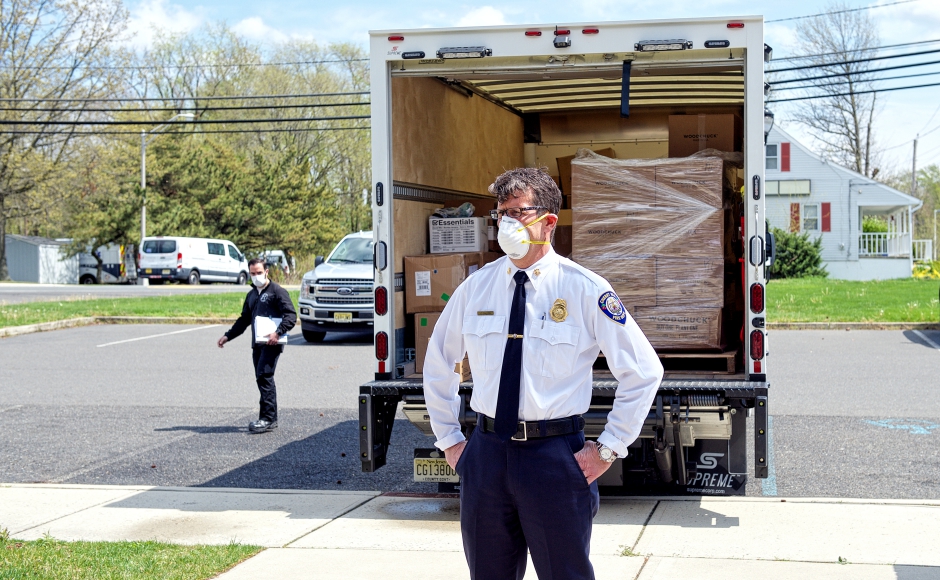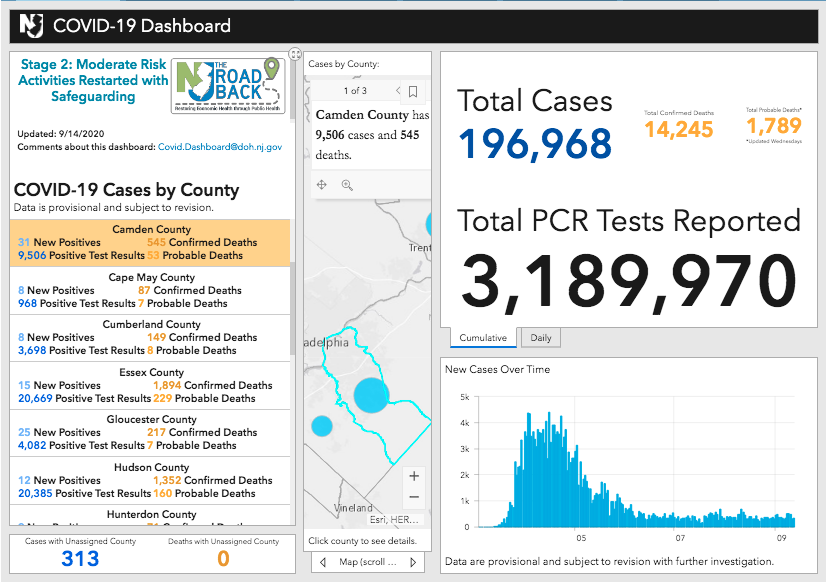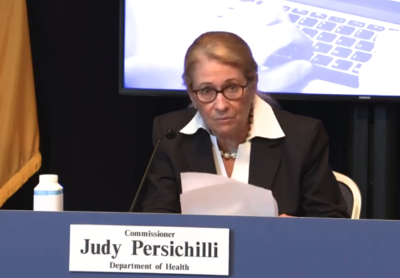New Jersey Health Commissioner Judy Persichilli urged residents to get a flu shot by October at the latest to help safeguard against influenza, as new contact tracing efforts are piloted at college campuses.
By Matt Skoufalos | September 14, 2020
Another 346 New Jersey residents have tested positive for novel coronavirus (COVID-19), bringing the statewide total to 196,968 cases, Governor Phil Murphy reported Monday.
Sadly, three more residents have perished from complications related to the virus, bringing the statewide death toll to 14,245 lives lost during the pandemic.
All three of those deaths happened within the past week, Murphy said.
In addition to those lab-confirmed fatalities, the state has acknowledged another 1,789 probable COVID-19-related deaths.
In the past six months, 261 of every 100,000 New Jersey residents have been hospitalized with COVID-19, and 162 of every 100,000 have died from COVID-19-related complications.
More than 3 million people have been tested for the virus statewide, with a 2.2-percent positivity rate per 100,000 residents.
Rate of transmission (Rt) at 1.06, spot positivity highest in South Jersey
The statewide average of COVID-19 spot positivity testing stood at 1.82 percent September 10. In South Jersey, it was higher, at 2.84 percent.
Rt, the variable that describes the seven-day, rolling-average rate of transmission of new COVID-19 cases, hit 1.06 from samples taken September 12.
An Rt figure greater than 1.0 means that each new COVID-19 patient is infecting more than one other person, on average, and the spread of the virus is increasing.
Since its mid-April COVID-19 spike, the highest reported RT in New Jersey was 1.48, recorded August 1. The lowest was 0.62, recorded June 9.

At the Camden County Office of Emergency Management, Cherry Hill Fire Chief Chris Callan oversees a delivery of personal protective gear for long-term care sites. Credit: Rich Ratner.
Long-term care accounts for half of all deaths, a fifth of those infected
Throughout New Jersey, 420 people currently are hospitalized with a case of COVID-19: 216 have tested positive for COVID-19, and 204 are awaiting confirmation of their symptoms.
Among those hospitalized patients, 91 are in intensive or critical care, and 41 of the ICU and critical-care patients (45 percent) are on ventilators.
Across the state, 688 long-term care (LTC) centers have reported at least one case of COVID-19, and 159 are dealing with an active outbreak. LTCs account for 38,401 infected patients and staff in New Jersey, or 20 percent of total cases.
That includes 24,960 residents and 13,441 staffers sickened by the virus, as well as 7,132 lab-confirmed resident and staff deaths (50 percent of the statewide total), with facilities self-reporting 121 staff deaths.
Of 656 veterans residing in a state-run home, 388 residents have tested positive for COVID-19, and 146 have died from complications related to the virus. Nine veterans presently are hospitalized with COVID-19, and 242 have recovered from the virus.
At state-run psychiatric facilities, 214 of 1,196 patients and 519 staff members have tested positive for COVID-19. Thirteen patients and seven staffers have died from complications related to the virus.
To date, 57 New Jersey children aged 1 to 18 have been diagnosed with pediatric multisystem inflammatory syndrome, New Jersey Health Commissioner Judy Persichilli said.
All those pediatric patients have tested positive for an active COVID-19 infection or the presence of COVID-19 antibodies, indicating exposure to the virus. No deaths have been associated with this syndrome in New Jersey, although several children have been hospitalized during their treatment.
With flu season approaching, NJ could face a ‘twindemic’ this fall
On Monday, Persichilli warned that New Jersey could face the possibility of “a twindemic” this fall, as health officials prepare for managing flu season while still trying to tamp down the impact of COVID-19.
However, reports from countries across the southern hemisphere suggest that the same safeguards against coronavirus—face coverings, hand-washing, and social distancing—may help lead to a less intensive flu season, Persichilli said.
The biggest question for residents who start to feel under the weather, however, will be whether they can quickly determine if they’ve contracted the flu or COVID-19. The commissioner said she believes “point-of-care testing is going to be very important, primarily in physician offices and emergency rooms.”
Persichilli also advocated for those aged six months and older getting a flu shot by the end of October, at the latest. It can take as long as two weeks for the body to develop antibodies after vaccination, and flu season can last until early spring, the commissioner said.
“The healthy-people target for flu vaccinations is 70 percent,” she said. “Nationally, and in New Jersey, less than half of healthy people received the flu vaccine.”
Next week, health officials across New Jersey, New York, Pennsylvania, and Delaware will also begin piloting COVID-19 contact tracing software on college campuses. Perschilli said the app could use location services and contact tracing data to digitally notify people anonymously if they’re encountering a COVID-positive person.
Rowan University has seen an increase in cases, “thanks to off-campus housing,” said Dr. Ed Lifshitz, who directs New Jersey’s communicable disease service.
“Whenever you have young people gathering, we certainly expect that to happen,” Lifshitz said, adding that the university is “working very closely with the local health department” to address conditions in Glassboro. Lifshitz also noted that, with 1.4 million schoolchildren in New Jersey, transmission of the virus through the public school system is “likely at some point.
“This is the reason why we set up these surveillance systems; this is the reason why we put out all this information to the schools,” he said.
“First off, to do everything that is reasonable to prevent that from happening in the first place,” Lifshitz said. “When it does happen, it can be spotted as quickly as possible, and actions can be taken to keep it from spreading further.”
Read our ongoing round-up of COVID-19 coverage here.
Please support NJ Pen with a subscription. Get e-mails, follow us on Facebook, Twitter, and Instagram, or try our Direct Dispatch text alerts.







